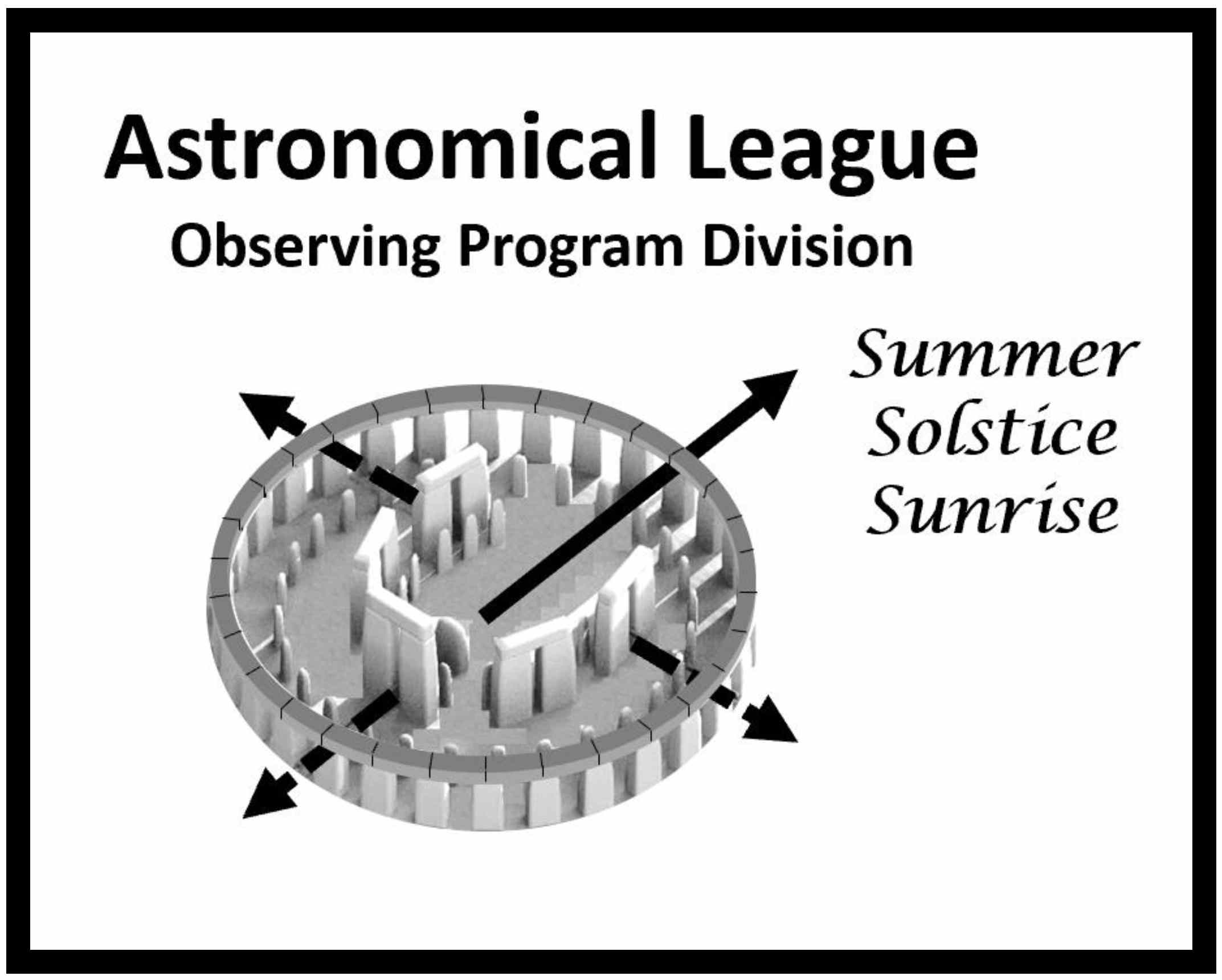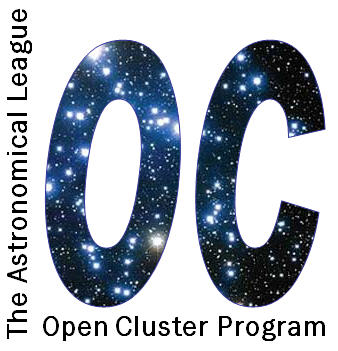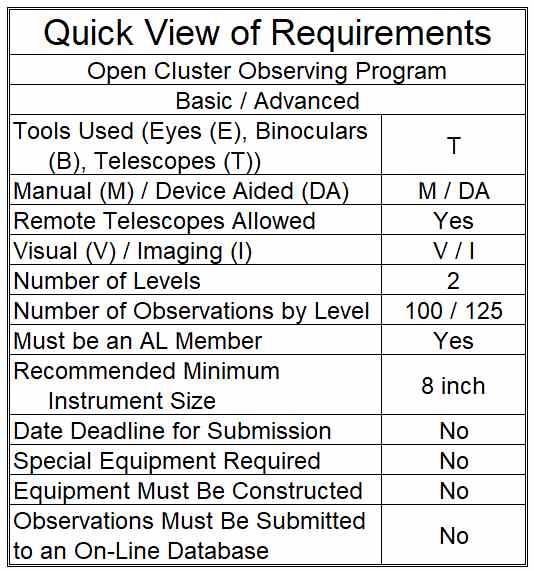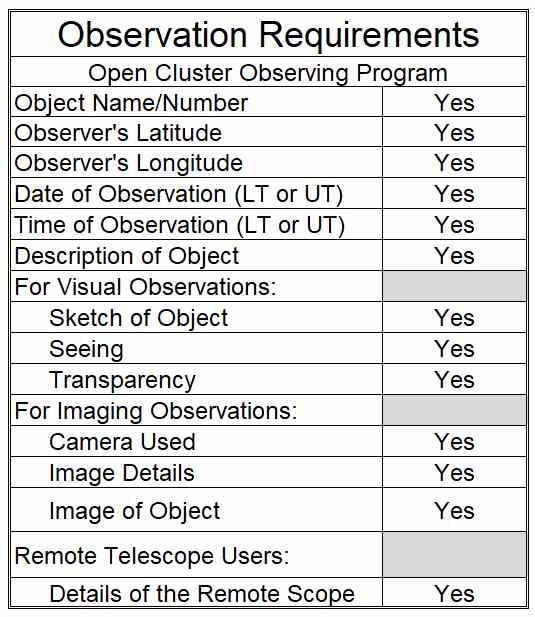Open Cluster Observing Program Coordinator:Cliff Mygatt |
  |
IntroductionImportant Notice: The Open Cluster Observing Program now allows imaging as an option for completion of the award. Remote telescopes are permitted in this Observing Program. Open clusters are of tremendous importance to the science of astronomy, if not to astrophysics and cosmology generally. Star clusters serve as the “laboratories” of astronomy, with stars at nearly the same distance and all created at essentially the same time. Each cluster is a running experiment, where we can observe the effects of composition, age, and environment. We are hobbled by seeing only a snapshot in time of each cluster, but taken collectively we can understand their evolution and that of their included stars. These clusters are also important tracers of the Milky Way and other parent galaxies. They help us to understand their current structure and derive theories of the creation and evolution of galaxies. Just as importantly, starting from just the Hyades and the Pleiades, and then going to more distance clusters, open clusters serve to define the distance scale of the Milky Way, and from there all other galaxies and the entire universe. However, there is far more to the study of star clusters than that. Anyone who has looked at a cluster through a telescope or binoculars has realized that these are objects of immense beauty and symmetry. Whether a cluster like the Pleiades seen with delicate beauty with the unaided eye or in a small telescope or binoculars, or a cluster like NGC 7789 whose thousands of stars are seen with overpowering wonder in a large telescope, open clusters can only bring awe and amazement to the viewer. These sights are available to all. Whether a large or small telescope is used, whether one observes with only binoculars or the unaided eye, or whether one observes from a dark sky location or a light-polluted city, these clusters are there waiting on any clear night for us to take a look. Performing this program and receiving the certificate and award pin, signifies that you too, have undertaken the task of studying these wonderful and diverse star systems and hopefully, have a new understanding and appreciation for these deep sky objects. |
 |
Requirements and Rules
This certification is available to members of the Astronomical League, either through their local astronomical society or as members at large. If you are not a member and would like to become one, check with your local astronomical society, search for a local society on the Astronomical League Website (click here), or join as a Member-at-Large (click here).
| The nature of this program is not just observation or imaging of the selected open clusters, but the ability to classify them based on the Trumpler classification system and the ability to sketch or image selected clusters. This, overall, enhances the observing experience and allows even the most advanced observer to find details in these clusters that are normally overlooked.
There are two levels within the Open Cluster Observing Program, Basic and Advanced. One must complete the Advanced Program to receive the lapel pin. Only the Advanced Program will be considered as a valid choice for the Master Observer Award. The Open Cluster Program has been updated with a supplemental list of 90 additional open clusters. Any of the open clusters on the original list and the new list may be used to complete the requirements. This change was made to enable observers in the southern hemisphere to complete this program. This change also allows you to choose the open clusters you wish to observe, providing more flexibility. We hope you enjoy this Observing Program and please let the coordinator know what you think. |
 |
Silver Level, Visual:
- Observe 100 of the open clusters on the provided lists.
- Sketch 25 of the open clusters that you observed.
- Classify all 100 of the observed open clusters using the Trumpler classification system.
- All observing techniques may be used under the basic program. Including Go-To, computer-controlled, star hopping, digital setting circles, imaging, etc. Remote telescopes are permitted for this Observing Program.
Gold Level, Visual:
- Observe 125 open clusters on the provided lists.
- Sketch 50 of the open clusters that you observed.
- Classify all 125 of the observed open clusters using the Trumpler classification system.
- All observing techniques may be used under the advanced program. Including Go-To telescopes, computer-controlled, star hopping, digital setting circles, imaging, remote telescopes, etc.
Silver Level, Imaging:
- Image 100 of the open clusters on the provided lists.
- Classify all 100 of the imaged open clusters using the Trumpler classification system.
- All observing techniques may be used under the basic program. Including go-to, computer-controlled, star hopping, digital setting circles, imaging, etc.Advanced Program, imaging, remote telescopes, etc.
Gold Level, Imaging:
- Image 125 of the open clusters on the provided lists.
- Classify all 125 of the imaged open clusters using the Trumpler classification system.
- All observing techniques may be used under the advanced program. Including Go-To, computer-controlled, star hopping, digital setting circles, imaging, remote telescopes, etc.
Those completing the Silver Level who would like to move up to the Gold Level must observe or image an additional 25 open clusters that were not observed under the Silver Level. Furthermore, the observer must sketch an additional 25 open clusters that were not previously sketched for the Silver Level.
The Trumpler Classification System: The observer is required to classify all of the open clusters observed in this program using the Trumpler classification system. Examples of some of the official Trumpler classifications are given on page 6. By classifying all of the open clusters, the observer will be developing a better understanding of their differences and appearances.
The Sketch (for visual observers): The observer is also required to make a sketch of any 25 (the Silver Level) or 50 (the Gold Level) clusters they observe. The sketch does not have to be a work of art, but it does need to accurately depict the cluster. Since open clusters are made of stars, a drawing of small dots in a pattern of the cluster is all that is needed.
The Image (for imaging observers): An image for 100 (the Silver Level) or 125 ( the Gold Level) must be included with your submission. Also include the imaging equipment used and any processing programs required.
Because the goal of this program is to have the observer see the differences in the clusters, it is highly recommended that the same telescope and similar power be used for all of the clusters. By doing this, it will ensure that the differences that are seen are cluster differences and not power differences.
Observations: For each object, the observer is required to record the location (Latitude and Longitude), date and time (Local Time or UT), Seeing and Transparency, telescope aperture, power, and a brief description of the observed object, the Trumpler classification, and a sketch for any 25 (Silver Level) or 50 (Gold Level) or, if imaging, an image of any 100 (Silver Level) or 125 (Gold Level) and include the equipment and processing used for clusters from the lists; a sample is on page 11. This format follows that of most Astronomical League observing programs. If the format that you use is more detailed, just make sure that the basic requirements are recorded like they are on page 11 of the Open Cluster Program Observing Manual.
Submitting for CertificationAwards: Once you have met the above requirements, send in your observing logs, program completed (Silver Level or Gold Level), name, mailing address, email, phone number, affiliation (club association or member-at-large), and to whom the certification should be sent, to the Coordinator of this Observing Program. Your Astronomical League Awards representative may send in your logs to the Program Coordinator as well. Make sure you send COPIES of your logs and not originals because the administrator of this program will not mail back your logs. |
 |
The individuals completing the Gold level will receive special recognition on their certificate.
Furthermore, only the Gold Level awards will receive the lapel pin and count towards the Master Observer Award. Keep this in mind when picking what to observe.
Upon verification of your submission and of your active membership in the Astronomical League, your recognition (certificate, pin, etc.) will be sent to you or to the awards coordinator for your society, as you specified. Your name will also appear in an upcoming issue of the Reflector magazine and in the Astronomical League’s on-line database. Congratulations. Good luck with your next observing challenge.
Open Cluster Program Coordinator:Cliff Mygatt |
Links:
- Open Cluster Program Observing Manual (includes original list of Open Clusters)
- Supplemental List of Southern Sky Open Clusters (PDF format) (MS Excel format)
- Find Your Observing Program Award



